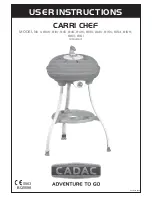
Note:
This may loosen the obstruction and allow you
to push past it.
2.
If the obstruction persists, try one or more of the
following options:
•
If the obstruction is in an area where you can dig,
stop the drill head with the Exit Side Lockout
and dig down to the obstruction to identify it and
remove it if possible.
•
Pull the drill head back 15 m (50 ft) or more and
steer the drill head to the side, marking a new drill
path around the obstacle.
Important:
Do not steer the drill head more
than 20 cm (8 inches) off center for every 3 m
(10 ft) of forward travel. If you steer more than
this, you will damage the drill pipes.
•
If the obstruction is actually a change in soil type,
such as a zone of rocky soil, pull the drill head all
the way back and change to a drill bit appropriate
for drilling through the new soil type.
Exiting the Ground
As you approach the end of the bore, steer the drill head to
the exit point, keeping the steering limits in mind as you do
so. Before exiting the ground, ensure that everyone is away
from the exit point. As soon as you break through, stop the
drilling-fluid flow. Extend the drill forward until the entire
drill head is out of the ground.
Backreaming and Pullback
After drilling the initial bore, you attach a reamer to the
pipe, which is then connected to a the product that you are
installing. The reamer is designed to widen the bore, pack the
walls, and lubricate the passage of the product into the bore.
The following reamers are available from your Authorized
Toro Dealer in various sizes to meet your needs and soil
conditions:
•
Carbide step-wing cutter
—Use this reamer in sandy
and medium clay soil conditions to mix the drilling fluid
with the soil, making a mixture that flows easily around
the product being pulled.
•
Cast cone packer
—Use this reamer in soils that pack
easily, such as soft clay, peat, and loam, to pack the sides
of the bore, maintaining the bore opening.
•
Fluted reamer
—Use this reamer in hard clay and rocky
soils; it combines the features of the other 2 reamers.
Connecting the Reamer and Product
WARNING
If the drill rotates or extends while you or others are
manually working on the drill bit or pipe in front
of the machine, the worker could get caught in the
bit or pipe, causing serious injury, amputation, or
death.
•
Enable the exit-side lockout on the
exit-side-lockout transmitter before approaching
the dill bit or pipe when attached to the machine.
This will disable the drill carriage.
•
Do not wear loose clothing or jewelry when
working on a drill bit or pipe attached to the
machine. Tie long hair up and out of the way.
1.
Using the exit-side-lockout transmitter, enable the exit
side lockout.
2.
Remove the drill head from the lead bar.
3.
Double check the reamer to ensure that the fluid ports
are clean and free from obstructions.
4.
Install the reamer and swivel onto the end of the lead
bar as directed by the reamer manufacturer.
5.
Connect the product to the reamer using an appropriate
pulling connection; refer to your Authorized Toro
Dealer to acquire the appropriate puller to meet your
requirements.
72
















































